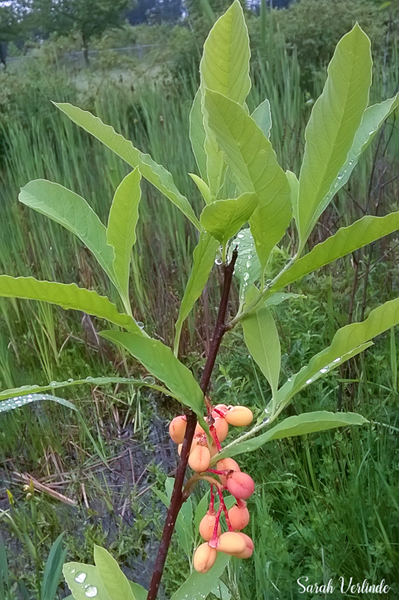Osoberry
Oemleria cerasiformis – Osoberry
At a Glance:

- Family: Rosaceae
- Plant Type: deciduous spreading erect shrub
- Distribution: Pacific Coast, California to British Columbia
- Habitat: open woods in low elevations
- Height: 1.5-3m
- Flower/Fruits: Male and female flowers hang as a pendant in racemes/clusters. Flower petals are white to pale-green, creamy, or pale-yellow in color. Fruits are purple and look like a tiny plum.
- Flowering Season: February – April
- Leaves: oblong-lanceolate/elliptic to spatulate in shape and up to 12cm long.
- Generation: Perennial
- Notable features: one of the earliest bloomers in late winter and early spring. These plants are monoeicious, meaning there are male and female trees. In spring, early leaves can be crushed in the fingers and they often smell like cucumber.
Restoration and Conservation
In the Pacific Northwest, Osoberry is one of the earliest bloomers, providing a nectar source to hummingbirds, butterflies, bees, and other pollinators. It is easy to propagate, especially as live stakes, keeping restoration costs lower than purchasing fully potted plants. It does very well in disturbed areas, great for planting along roadsides and trails.
Ethnobotany
Many Coast Salish groups would eat the berries cooked, dried, or fresh in small quantities. The twigs could be chewed and applied to sore places on the body externally, and the bark has been used as a mild laxative.
References and Resources
- Pojar, J and MacKinnon, A. 2004. Plants of the Pacific Northwest Coast: Washington, Oregon, British Columbia and Alaska. Vancouver (BC): Lone Pine Publishing.
- USDA: https://plants.usda.gov/factsheet/pdf/fs_oece.pdf
- WTU Image Herbarium: http://biology.burke.washington.edu/herbarium/imagecollection/taxon.php?Taxon=Oemleria%20cerasiformis
This article was written by Sarah Verlinde. For questions regarding the UWB/CC Plant Tour, contact Sarah at severlin@uw.edu.
